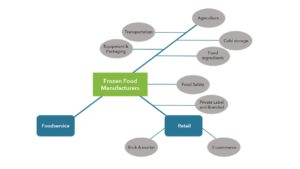Strategic partnerships continue to play an important role in helping industries position for growth. The most fertile ground for nurturing strategic partnerships within any given industry is through trade associations. That assertion should be obvious to all industry leaders, but if widespread adoption is a fair indicator, the results are not there. The good news is that several industry and trade association strategic partnerships are taking hold and they are changing the game. One of the more effective collaborations is between the Frozen Food Industry and the American Frozen Food Institute (AFFI), their relationship demonstrates that this strategic partnership drives Frozen Food Growth.

Alison Bodor, President and CEO of AFFI
Through its Strategic Industry Plan the American Frozen Food Institute (AFFI), Alison Bodor, president and CEO, and its board of directors are pursuing strategies to build upon its foundation and continue its double digit growth. Applying the industry Strategic Plan as the AFFI roadmap, they build upon their strong foundation:
- Grounded in science, mitigate risks to the frozen food business.
- Elevate frozen’s voice and build champions to promote the benefits of frozen foods
- Drive solutions for innovative category performance.

When it comes to driving solutions for innovative category performance, AFFI utilizes its strategic partnership between itself and FMI—the Food Industry Association, which represents food retailers (grocery companies), to implement an effective Power of Frozen initiative. Their shared objective was to reset the conversation around the frozen food category by doing in-depth market research, collecting retail sales data—overlaying that with consumer trends and identifying opportunities for both retailers’ and manufacturers’ strategies to expand the frozen food industry. They were able to use that information effectively in dealing with both the business media and with consumer media to share the benefits and business of frozen. It allowed them to articulate how those benefits are translating into sales.
The first major research and data collection was accomplished in 2018. The study essentially combined IRI retail purchasing data with survey research designed to collect primary data from consumers, evaluating their consumption, purchase drivers, and use of frozen foods. The data was shared with FMI and AFFI members in 2019 in the first Power of Frozen report. They shared this primary consumer data with the entire food industry so that all stakeholders would appreciate what was happening in the category.
Two discoveries were of special interest to AFFI:
- Consumer interest in the frozen category was already in the midst of a revival. In 2018, both dollar (+2.6 percent) and units (2.3 percent) grew, with nine out of 10 top-selling Categories up in dollars and all 10 up in units. The landscape was already improving markedly.
- The data had zeroed in on the core frozen-food consumer, which turned out to be an older millennial, working, with children.
A tremendous amount of innovation was already being done in the frozen category over the 2015–2017 time frame. Companies had completely revamped product, streamlined ingredient declarations, and modernized the category to suit consumers’ needs, especially around quality, taste, variety, and health.
AFFI’s Alison Bodor told the story of the meteoric rise of frozen during the pandemic: The frozen category had already begun to pick up noticeably in 2017 and 2018. And the same again in 2019. And then COVID-19 hit. From her perspective, “Frozen was the right food at the right time during the pandemic. Consumers were looking to reduce their grocery store trips. People were at home, preparing three meals a day. That’s a lot of time in the kitchen when you’re trying to balance home life and your job while your kids are also at home doing school on the computer. It was a lot to juggle. Frozen meals were a real solution for working parents especially. Frozen gave consumers the convenience, comfort, variety, and healthiness that consumers were seeking.”
Reflecting back, Alison notes “We saw that growth extend by over 20 percent during the pandemic. We brought new consumers to the category. And we also increased our interaction, our engagement with the consumer across all meal solutions. That growth is a silver lining for the frozen food industry from this horrible pandemic. Our goal as an industry is to keep the consumers who discovered frozen foods during COVID and to maintain the increased engagement by our core millennial consumers.”
The frozen food industry is growing. And it is changing all the time. Years from now leaders in the frozen food industry may look back at the pre-and post-COVID-19 timeframe as an inflection point. Consumer tastes were changing, baby boomers were no longer the dominant demographic, and millennials would come to rely on food sources that included more options that are tasteful, healthy, and safe choices for themselves and their families. Topline growth performance, while impressive during the pandemic is still strong, showing double digit growth post pandemic.
One of the key takeaways in strategic partnership comes down to leadership from the industry and its trade association. Frozen food industry leaders reflected deftness and fluidity in how they managed and connected with their consumers. AFFI aligned with the same characteristics but elevated its leadership for the industry at new and different levels. The bottom line is clear, this Strategic Partnership Drives Frozen Food Growth.
Book Dan Varroney as a speaker for your meeting, conference or group and learn how to tap into the potential of strategic partnerships with industry associations from the author of the groundbreaking book, Reimagining Industry Growth.





